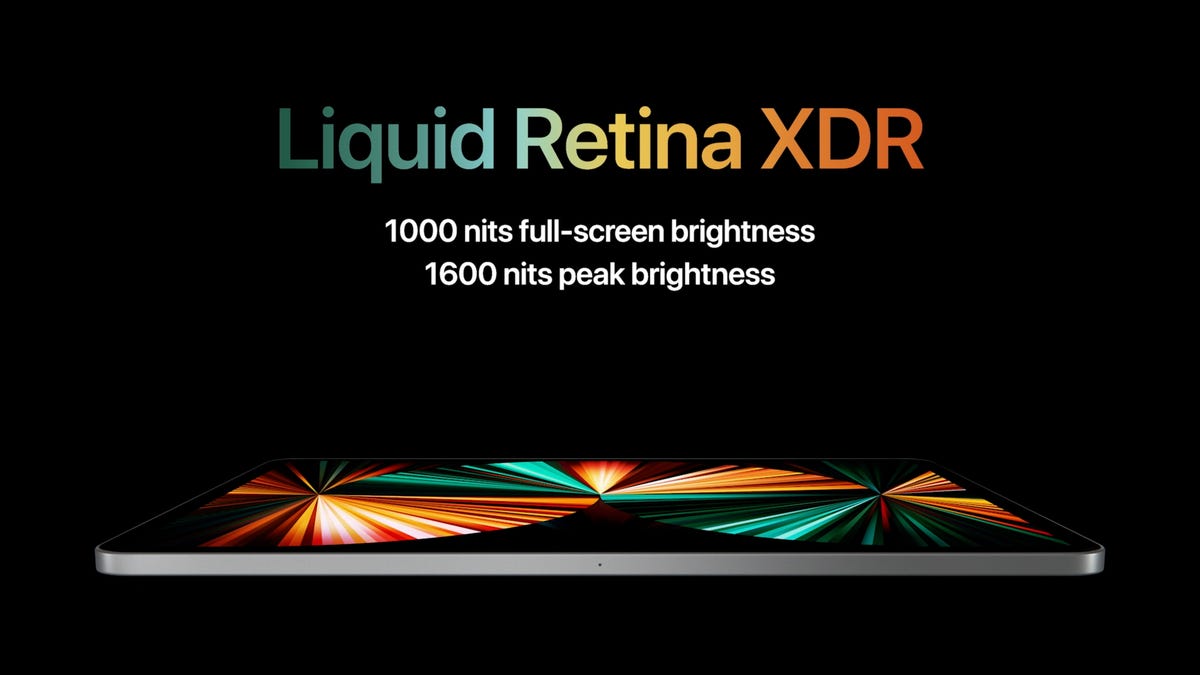Apple 12.9-inch iPad Pro has Liquid Retina XDR display with eye-watering specs
The new iPad Pro gets a mini-LED-powered, local-dimming screen that, on paper, looks worthy of pro-level monitors and high-end TVs.

This could be the best tablet screen ever. On Tuesday at its Spring Loaded event, Apple announced a new iPad Pro, and one of the biggest upgrades is the screen. It uses a technology called mini-LED that is said to offer improved power efficiency and better brightness to handle the demands of HDR video.
Available only on the 12.9-inch version of the iPad Pro, which starts at $1,099 (£999, AU$1,649), Apple calls the screen Liquid Retina XDR. It shares many of the same attributes as Apple's Pro XDR display, a $6,000, 6K-resolution monitor. It can deliver 1,600 nits peak brightness, and 1,000 nits full-screen brightness. That's higher than many HDR TVs and should amply convey the realistic highlights that make HDR really pop.
The key is its mini-LED backlight array, which has 10,000 individual light-emitting diodes and 2,596 local dimming zones. Apple says each LED is 100 times smaller than a standard version, and with that many zones the screen's ability to control lighting, and create high contrast, should be excellent. The company touts a 1,000,000:1 contrast ratio, for what that's worth.
Beyond brightness and contrast, the Liquid Retina XDR screen has a P3 wide color gamut and retina resolution of 5.59 million pixels. It also has a 120Hz touch-sensing rate for smoother motion, and is compatible with HDR10, HLG and Dolby Vision HDR formats.
See also
Mini-LED is a big deal
Mini-LED is an evolutionary technology, not a revolutionary one, and draws on existing LCD tech. All LCD-based screens, including Apple's new iPad, use light-emitting diodes to shine through a liquid crystal layer that houses the pixels themselves. That's fundamentally different from more revolutionary technologies, like OLED and MicroLED (see below), which omit the extra layer and allow each individual pixel to emit light.
Although this is the first time it has appeared in an Apple device, mini-LED screen technology isn't new. It's used in high-end computer monitors like the ViewSonic XG321UG and Dell UP3221Q. Mini-LED is also found on TVs, the first of which was the excellent TCL 8-Series in 2019, followed by one of CNET's favorite TVs for the money, the 2020 TCL 6-Series. This year other TV makers followed suit; both Samsung Neo QLED and LG QNED TVs use mini-LED backlights.
OLED is another screen technology found on numerous displays today, and unlike mini-LED, its pixels emit light directly, no liquid crystal layer required. Displays that use organic light-emitting diodes have better contrast and off-angle viewing, although they're not as bright. In CNET's tests of mini-LED TVs we've found some benefits like better brightness for the money and more precise local dimming, but they're still not as good as OLED TVs. Our tests of OLED-based laptops and tablets found similar differences.
Apple has used OLED displays in its best iPhones over the last few years, but for the new iPad it went with mini-LED instead. In addition to the brightness advantage, another reason could be battery life. Since it can individually control pixel brightness values, OLED is more power-efficient overall than LCD for mixed content. But for a mostly white screen, like when you're shopping on white-background Amazon or working in white-background Google docs, firing up all those OLED pixels to a comparable brightness takes a lot more power. That might make more of a difference on a larger tablet or laptop screen compared to a phone.
And don't confuse Apple's mini-LED display with MicroLED, a more futuristic technology that's reserved for huge screens and rich people today -- like a 110-inch Samsung TV that costs $156,000. Sony and Samsung also use MicroLED for large professional displays, and a huge MicroLED screen is used on the set of The Mandalorian to replace green-screen compositing.
Just like OLED, MicroLED displays use millions of LEDs, one for each pixel. Essentially, you're looking directly at the LEDs that are creating the picture. And each individual LED is smaller, as you might expect, than a mini-LED. Another benefit is that MicroLED is less susceptible to image retention and burn-in than OLED.
Apple was rumored to be developing a MicroLED display for the Apple Watch, but so far that hasn't materialized.
We look forward to testing Apple's mini-LED iPad screen soon.
CNET's Lori Grunin contributed to this article.

